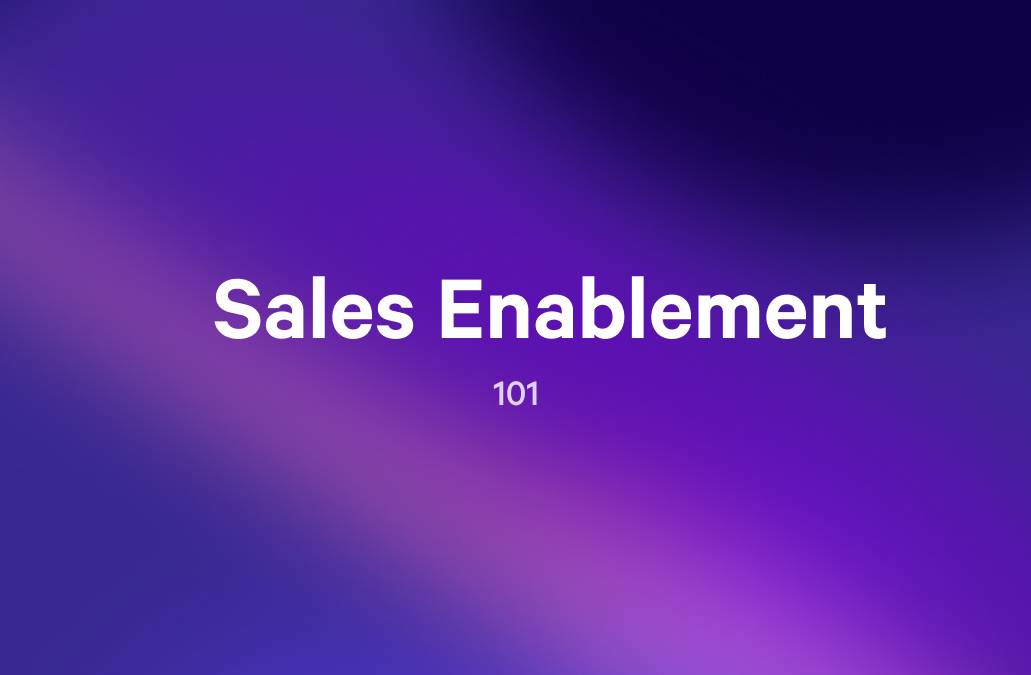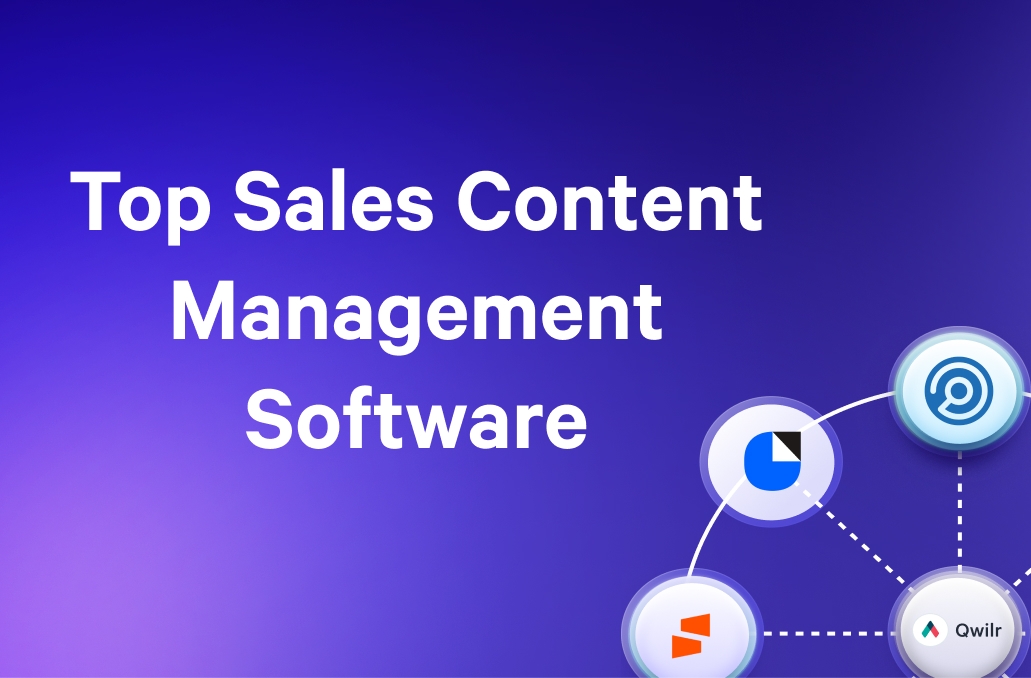How are sales enablement strategies evolving in 2024? Which techniques are proving most effective right now? What aspects of your approach should you optimize?
As a sales leader, you are under constant pressure to align sales processes with the company's broader objective. In between ensuring the sales team is equipped with the right sales tech stack, knowledge, and content they need to be successful, fostering continuous improvement, and more— there’s a lot on your plate.
Does this mean you should abandon your efforts in sales enablement altogether? Not at all. These strategies remain crucial, but you'll need to adapt your approach.
Whether you're crafting a new sales enablement strategy or refining an existing one, this guide offers fresh perspectives to evaluate and enhance your approach helping you optimize your sales enablement process for better results.
But first the basics…
Key Takeaways
- Effective sales enablement strategies are crucial for aligning sales processes with company objectives and equipping sales teams with the right tools, knowledge, and content.
- Continuous improvement and adaptation are key in sales enablement, as market conditions and customer needs evolve rapidly.
- Regular assessment and optimization of sales processes contribute to increased efficiency and better outcomes.
Why is a sales enablement strategy important?
A well-crafted sales enablement strategy acts as a compass, aligning your team's efforts and ensuring that every action contributes to your overarching goals. Without it, even the most talented salespeople can find themselves adrift in a sea of information, tools, and competing priorities.
In the absence of a cohesive strategy, your investments in tools, training, and content risk becoming disjointed efforts that fail to drive meaningful results—it’s like throwing spaghetti on the wall, hoping something is going to stick!
Bottom line: a solid sales enablement strategy isn't just nice to have. It's what turns all your efforts into actual results. It's what keeps your team focused and effective, and increases their sales productivity, even when everything around them is going haywire.
Components of a successful sales enablement strategy
Qwilr found that sales enablement strategies lead to an 8% increase in quarterly revenue and a 49% win rate on forecasted deals.
But what makes a sales enablement strategy truly effective? Let's break down the five essential components that transform a good plan into a great one:
Strategy formulation
This involves creating a realistic plan to support your sales team. For example, before implementing a new content management system, assess if your team has the necessary skills and if the system aligns with your sales process. This ensures your enablement strategy addresses real needs.
Execution planning
This step outlines the implementation process. When rolling out a new sales playbook, clearly define who will create the content, who will deliver the training, and when each stage will be completed. This clarity helps ensure smooth implementation.
Want to know more? Find out how to create an implementation plan.
Performance management
Here, you set specific metrics to measure the impact of your enablement efforts. For instance, after implementing a new training program, track metrics and sales enablement KPIs like time-to-first-deal for new hires or improvement in win rates. This helps quantify the value of your enablement initiatives.
Strategy communication
This involves effectively conveying the purpose and benefits of your enablement efforts, including nailing sales and marketing alignment. When introducing a new sales intelligence tool, demonstrate how it will help reps identify promising B2B leads more quickly. The goal is to generate enthusiasm and adoption among your sales team.
Organizational bandwidth
This ensures that your enablement team and sales managers can implement and support new initiatives. It might involve hiring dedicated enablement specialists or reallocating responsibilities to create time for coaching and reinforcement of new skills or tools
How to build an effective sales enablement strategy?
To build an effective sales enablement strategy, start by understanding your sales team's needs and the buyer's journey. Provide them with the right tools, resources, and training to help them engage prospects effectively. Ensure that sales and marketing are aligned, so messaging is consistent. Regularly review and update the strategy based on feedback and results, keeping it flexible to adapt to changing market conditions.
Tania Clarke, Head of Product Marketing at Qwilr, explains:
“Creating an effective sales enablement strategy starts by understanding the buyer’s journey and what content they need to evaluate your tool or offer. From there you can identify gaps in the content journey and what needs to be fulfilled by external content buyers can self-serve with, or internal enablement that equips sales reps with vital information. Think of your sales enablement content as an MVP and one that evolves with a strong feedback loop from your sales team. It's not a set-and-forget content creation project.”
No matter if you're a rookie or a veteran in sales enablement, it's always a good idea to periodically evaluate your sales enablement strategy, making sure it's innovative, engaging, and aligned with the changing needs of your sales team and customers.
Erman Ergun, Head of Sales Enablement at Jotform reiterates:
“A top-notch sales enablement strategy is like a well-oiled machine. It kicks off with continuous training and development, so your sales reps are always on top of their game. You need to whip up relevant, practical content like playbooks, case studies, and product info that your team can easily use. The topics for these are best selected by getting feedback from your sales team.”
17 effective sales enablement strategies
Now that you have learned about the key components of a sales enablement strategy and how to build one from scratch, let’s evaluate powerful sales enablement strategies that will help you reach your prospects and boost conversions.
#1 Align your sales objectives with set enablement goals
When enablement efforts remain aligned with the broader business objectives and adapt to changing market conditions, you witness many benefits surface, such as:
- It keeps your training in line with what the company actually needs
- It helps spot areas where your team might need more help or knowledge
- It makes it easier to see if your training is working, since you can measure progress
Say your business goal is to expand into a new market segment. To achieve this your sales enablement goals might focus on educating the sales team about the specific needs and pain points of this new customer base through a training plan that changes and improves as your business needs change.
Bottom line: without linking sales goals to enablement, you might waste time and resources on unhelpful training. Your team could struggle to meet their targets, not knowing why.
#2 Create a sales enablement charter
A sales enablement charter is a simple document that outlines how you'll support your salespeople to help them sell better. Creating this charter is a smart move for any company wanting to improve its sales.
Here's why it's helpful:
- It gives everyone a clear picture of what you're trying to achieve
- It gets all departments working together to support sales
- It helps you measure if your efforts are working
- It makes planning for resources and tools easier
The key components of a sales enablement charter are:
- Mission statement: A short sentence explaining the main goal. For example, "To equip our sales team with the skills and tools to increase sales by 20% this year."
- Objectives: Specific targets you want to hit. Like "Improve product knowledge" or "Reduce sales cycle time."
- Strategies: How you'll achieve these objectives. This might include "Provide weekly training sessions" or "Create easy-to-use sales materials."
- Roles and responsibilities: Who will do what. For instance, "Marketing will create product sheets" or "IT will set up a new CRM system."
- Timeline: When you expect to complete different parts of the plan.
- Success metrics: How you'll measure if it's working. This could be "20% increase in sales" or "50% faster response to customer inquiries."
- Resources needed: What tools, budget, or people you'll need to make it happen.
For example, part of your charter might read: "By Q3, we'll implement a new sales methodology (led by Sales Training), create supporting materials (developed by Marketing), and track both leading metrics like 'adoption rate of new process' and lagging metrics like 'increase in average deal size' to measure success."
With this comprehensive charter in place, your entire organization will understand how to support and improve your sales enablement efforts.
#3 Identify your target audience and create ideal customer personas
Truly effective sales enablement requires tailored content that addresses the specific needs of your sales ideal customer personas or Sales ICPs.
That’s because when you are selling to everyone, you are not selling to anyone! Having clear sales ICPs helps you focus your sales efforts on the right people, create more relevant sales materials, improve how your team talks to potential customers, and can lead to more successful sales and happier customers.
Qwilr’s Product Marketing Manager, Guy Hall explains:
“Know your audience. Without a clear understanding of your ICP, and the pains that your product/services address, it's impossible to create effective enablement materials. Take the time to develop a firm grasp of exactly who will be receiving your content and what is relevant to them. These foundations will then allow you, and your sales team, to flourish.”
While Sales ICPs are very detailed, personas help humanize them. For example, you might create a persona called "Marketing Manager Mary." She works at a mid-sized company, is always busy, and needs help reaching more customers online. Your sales team can use this information to tailor their approach, maybe by showing Mary how your product saves time and improves online reach.
#4 Evaluate your budgets
Evaluating budgets is a crucial strategic step when running a sales enablement program. Let's say you want to implement a new sales training program. If you evaluate your budget first, you might realize you can't afford fancy in-person workshops for everyone. Instead, you could opt for a mix of online training and smaller group sessions, which still improve skills but fit your budget.
If you skip this step, a few problems could happen:
- Running out of funds: You might start a big training program but can't finish it because you ran out of money.
- Wasting resources: You could spend too much on less important things and not have enough for critical needs.
- Inability to plan long-term: Without knowing your budget, it's hard to make plans
So if you’re looking to make smart investments in your team's growth, ensuring every dollar spent moves them closer to their sales goals, you need to put proper budgeting in place.
#5 Identify key stakeholders
There’s nothing more pivotal than having key stakeholders by your side when executing sales enablement. While it may seem like a simple step, more often than not it is the hardest. Having access to key stakeholders ensures that you have buy-in from all parts of the organization, have diverse perspectives and expertise and you are well prepared to overcome potential obstacles.
Not identifying key stakeholders can lead to:
- Lack of support from important decision-makers
- Misalignment between different departments
- Overlooking critical needs or challenges
- Difficulty in implementing and sustaining the program
But which stakeholders should you lean on? There’s no straightforward answer to this question as a lot will depend on your organization’s structure, however below are a few stakeholders that you should look into:
- CEO or COO for overall strategy alignment
- CFO for budget approval
- Sales leadership for setting goals and priorities and sales team feedback
- CMO or Marketing Manager for aligning sales and marketing efforts Front-line sales representatives:
- Experienced salespeople for practical insights
By getting everyone involved, you create a strong, well-rounded program that addresses needs across your entire organization.
Struggling to identify decision-makers? Take some advice from Qwilr’s Enterprise Account Executive, Steve Findley:
“Be curious during your discovery and demo calls, offer prospects the option to invite decision-makers to these calls and/or share content that they can use internally so that you can identify decision-makers via analytics. Research the company online to help build a bigger picture.”
#6 Identify and analyze your high-performers
Your top sellers hold the key to unlocking greater potential across your entire team.
Think of it this way: if you've got a salesperson consistently crushing their targets, wouldn't you want to know their secret sauce? Maybe they've mastered a specific pitch technique or found a clever way to use your product demos.
By identifying these winning tactics, you can equip your entire team to excel, replicate their success strategies across the team, improve your training programs, and refine your sales processes. Ultimately, this approach fosters a culture of continuous improvement and shared knowledge, transforming your sales enablement from a one-size-fits-all program into a dynamic, evolving system that's always adapting to what works best in the real world.
#7 Develop a comprehensive onboarding program for new hires
If you want to avoid new hires taking months to become effective sellers, and not lose out on sales opportunities due to a lack of product knowledge, you need to prioritize and develop a comprehensive onboarding program.
With a strong onboarding program, salespeople might spend their first week learning about the company's products, practicing demo presentations, and shadowing experienced team members. This way, they're ready to start making calls and closing deals much faster.
On the flip side, without proper onboarding, that same new hire might spend weeks or even months figuring things out on their own, making mistakes, and missing out on sales opportunities.
#8 Provide role-specific training
As a sales leader, you do know the significance of training your sales teams, after all, the average ROI of sales training is an impressive 353%, demonstrating the substantial returns that can be achieved through focused training efforts.
BUT are you dropping the ball on role-specific training, and offering a one-size-fits-all approach to your sales team? You might think that the same general sales training is efficient—but here’s the thing: it’s like teaching everyone on a football team how to be a quarterback - it's not helpful for the defenders or the kickers
It's crucial to provide role-specific training because different sales roles often require different skills and knowledge. For example, an inside sales rep needs strong phone and email skills, while a field sales rep might need more in-person presentation skills.
Again, you may have a product that caters to different tiers of customers. In such cases, the sales reps dealing with smaller accounts need training on quick, high-volume sales processes. In contrast, those selling to enterprise clients need training on complex, long-term relationship building and navigating corporate hierarchies.
#9 Identify and test what content type resonates with your audience
Depending on the stage of their buyer’s journey, your sales team will find that some sales enablement content assets work better than others as different customers prefer specific types of information.
Without identifying and testing the “right” content your sales team is wasting efforts, disengaging prospects, and missing sales opportunities.
A great tip from Tania is to “Focus on the highest value tasks, and deeply think about what the most valuable output would be. Reps aren't going to read a 5-page document on competitors, so always design content for real use vs best practice.”
Here’s a list of content types that you can align with your sales journey:
| Sales journey stage | Content types |
|---|---|
Initial Contact / Prospecting | Product Sheets, FAQ Sheets, Blog Posts (for reference) |
Discovery / Needs Assessment | ROI Calculators, Solution Guides, Customer Success Stories |
Solution Presentation | Sales Presentations, Product Demos, Competitive Battle Cards |
Handling Objections | FAQ Sheets, Competitive Battle Cards, Customer Success Stories |
Proposal / Negotiation | Proposal Templates, ROI Calculators, Implementation Roadmaps |
Closing | Proposal Templates, Product Sheets (for final confirmation), Implementation Roadmaps |
Post-Sale / Onboarding | Implementation Roadmaps, Product Demos (for team training), FAQ Sheets (for user support) |
Koala Content Report: What content converts best lists powerful insights (listed below) that can come in handy when deciding the ideal content for your company.
- Move beyond the demo & pricing page visit
- A lot of the best intent signals are hiding in the consideration part of the funnel
- Understand the high intent signals and build playbooks around it
- Content conversion highlights the buyer's journey for your product
- Differentiate and optimize PLG vs Sales led journeys
#10 Create a feedback loop between sales and product teams
Building a bridge that connects sales with different parts of your company is crucial for sales enablement to succeed. In a SaaS business, this feedback loop is particularly important because the product and market can change quickly.
Guy Hall drills down on why this is important for your sales enablement strategy:
“Communication and collaboration are crucial when it comes to a successful sales enablement strategy. You need to ensure that everyone is on the same page in terms of objectives and desired outcomes.”
But how do you go about it? Here are five practical tips for implementing feedback loops in your business:
- Schedule regular cross-departmental meetings where sales can share customer insights with product, marketing, and support teams.
- Use a shared digital platform (like Slack or Microsoft Teams) to create channels for real-time feedback and discussions between departments.
- Implement a system for sales reps to easily log customer feedback and feature requests directly into a database accessible by all teams.
- Create a monthly 'Voice of the Customer' report compiled by sales and distributed to all departments, highlighting key trends and requests.
- Rotate team members from other departments into sales calls or demos periodically to gain direct customer exposure and insights.
#11 Optimize your sales process

Many companies fail to see the need for continuous optimization of their sales process, often treating them as a "set it and forget it" task, which leads to many issues such as:
- Salespeople using outdated techniques
- Missed opportunities due to inefficient processes
- Longer sales cycles than necessary
- Inconsistent results across the sales team
Having a streamlined sales process can mean the difference between closing a deal and losing it to a competitor and not optimizing it means leaving money on the table. On the flip side, a well-oiled sales process means a shorter sales cycle, improved conversion rates, better customer experience, and more closed deals and referrals
#12 Build a content management strategy
Having an effective sales content management strategy as a subset of sales enablement functions can make the difference between a prepared, confident sales team and one that struggles to keep up.
It’s a winner and unlike tactical sales enablement, which might focus on immediate fixes like creating a single training program or tool, a strategic content management strategy considers the entire sales ecosystem, from onboarding to ongoing development. It ensures salespeople use the most up-to-date materials, there’s consistency in messaging, and allows tracking of which content is most effective.
#13 Regularly audit and update sales enablement materials and processes
Sales enablement has many moving parts and one of the most crucial steps is the need to regularly audit sales enablement materials and processes, and prune outdated information.
Why’s this crucial, you ask? For starters, it can lead to lost sales opportunities and confused salespeople.
For example, a SaaS company might continue using old product feature lists, ignoring recent updates or new integrations. This can result in salespeople missing key selling points or even providing incorrect information to potential customers.
To address this, implement tools like content management systems to track material versions, use analytics platforms to measure content effectiveness, and set up regular review cycles.
#14 Hire a sales enablement expert
It's surprising that even though top cloud companies have people dedicated to sales enablement, many businesses still struggle with it. Why? Well, it's not just about having someone with the title – it's about doing it right.

Here's the thing: sales is tough, and sales managers are usually swamped. They're busy chasing targets, coaching their team, and managing deals. So when companies say, "Hey, can you handle sales enablement too?" It's like asking someone who's already juggling to also ride a unicycle. It might seem doable, but something's bound to fall.
What happens next? The important stuff gets pushed aside. Training materials gather dust, new hires don't get proper onboarding, and the sales team misses out on using new tools or data that could help them sell better.
That's why having someone focused solely on sales enablement is important. By giving sales enablement the attention it deserves, companies can help their sales teams work smarter. Plus, it lets your sales managers focus on what they do best – leading their team to crush those targets.
#15 Introduce sales enablement software

Many companies overlook the importance of this sales enablement software, thinking their current methods are good enough. But that's like sticking with a flip phone in the age of smartphones.
For example, if your sales team is struggling to build sales proposals and quotes from scratch every time, they are essentially wasting productive hours. A proposal and documentation tool like Qwilr can significantly improve save time, reduce errors, and maintain consistency in their messaging.
By implementing sales enablement software, businesses can streamline their processes, ensure their team is always using the best and most current resources, and ultimately close more deals.
#16 Continuously improvise star content
Star content refers to sales enablement collaterals—think killer presentations, pitch decks, or product demos that consistently help close deals. But here's the thing - even hits can get stale.
Smart companies treat their star content like a living, breathing thing. They're always tweaking, updating, and refining based on what's working in the field. Maybe they notice a certain slide always gets prospects excited - so they expand on that. Or perhaps they spot a section that often leads to questions - so they clarify it.
So why is this crucial? It’s because markets, customer needs, and products are always evolving. What worked last quarter might not hit the mark today! When you continue to invest time in improvising your star content you’ll see better engagement from prospects, shorter sales cycles, and higher win rates.
#17 Measure and report
When companies don't measure, they often waste time and money on ineffective sales tools or training. They might keep using outdated materials just because "that's how we've always done it." Meanwhile, their sales team struggles, deals slip away, and no one knows why.
We get it—it may seem complicated or time-consuming, but this information is gold because it shows you what's working and what's not. Maybe that fancy new product demo video isn't as helpful as you thought, but the simple one-pager is a secret weapon. Without measuring, you're just guessing!
But here’s the thing: It's not about drowning in data, but about getting clear insights that lead to smarter decisions. For example, if you see that reps who complete a certain training course close 20% more deals, you know where to focus your efforts.
In the end, good measurement turns sales enablement from a nice-to-have into a powerful driver of business growth.
How to measure the success of sales enablement strategies
Chances are when you launch sales enablement at your organization, you want it to succeed. You want to know what's working and what's not if the program is actually helping and what areas need improvement. More importantly, you want to justify the investment in sales enablement. The big question remains— how do I measure its effectiveness?
All this is not possible with clearly defined KPIs, which work like a business scoreboard, showing you in clear numbers how close you are to reaching your goals. There are a variety of key performance indicators (KPIs) and metrics that you can evaluate based on how they align with your overall business goals.
Here's a quick rundown:
- Sales performance metrics: Win rates—are more deals closing, sales cycle length—is the process getting faster? Average deal size: Are reps selling higher-value solutions?
- Productivity metrics: Time spent selling vs. administrative tasks, number of customer interactions per rep, or quota attainment rates
- Content effectiveness: Content usage rates—which materials are reps actually using, content influence on deals—which pieces are associated with won opportunities etc.
- Training impact: Time to productivity for new hires or improvement in key skills after training sessions
- Customer-focused metrics: Customer satisfaction scores, retention rates or upsell/cross-sell success
Methods to track these could include:
- CRM data analysis
- Surveys (both internal for reps and external for customers)
- Content management system analytics
- Learning management system reports
Sales enablement is more than strategy and planning
It takes time, organization, and creativity to grow the sales enablement function.
Whether your goal is to enhance your team's capabilities, optimize your sales processes, or equip your representatives with high-quality materials, this guide offers comprehensive strategies to make it work. By following these steps and leveraging the available resources, you'll be well-positioned to implement a sales enablement strategy that drives performance and supports your organization's growth objectives.
About the author

Marissa Taffer|Founder & President of M. Taffer Consulting
Marissa Taffer is the Founder & President of M. Taffer Consulting. She brings over 15 years of sales and marketing experience across various industries to a broad range of clients.



